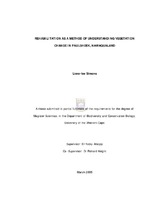| dc.description.abstract | Heavy grazing of rangelands in the succulent karoo has placed the biodiversity of these areas at risk. In Paulshoek, overgrazing has resulted in the removal of much of the palatable vegetation from low lying areas. The remaining vegetation is dominated by Galenia africana, an unpalatable shrub. Loss of favourable microsites, competition from Galenia africana, as well as loss of seed banks, may be the cause of poor seedling establishment of palatable species. I explored how high grazing pressure has changed this system by comparing with surrounding private farms, which have a history of less concentrated grazing pressure. I found that heavy grazing increased the seed bank of Galenia africana in the soil and reduced that of palatable perennials. Vegetation cover was significantly lower (p<0.0001) under heavy grazing and consisted mainly of Galenia africana and few palatable perennials. The aim of this study was to test techniques that could restore this area to a more productive palatable shrubland. I propose that rehabilitation can be used to gain an
understanding of the ecological factors that may be sustaining this altered vegetation state. My methodology involved biophysical interventions to manipulate this system. Grazing pressure was removed from the study area and vegetation changes were monitored under grazed and protected regimes. No change in plant cover was found after two years. However, there was an increase in cover of
palatable perennials in relation to overall cover. I physically manipulated the environment by introducing microcatchments and brushpacks to act as traps for water, seed and organic material. These interventions resulted in few changes, however, I found higher soil moisture levels in microcatchments and under brushpacks than open positions. Cover of ephemerals was also significantly higher (p<0.001) in areas that had been brushpacked. In the absence of a seedbank, I tested whether the introduction of seed would result in recruitment. Seed of four palatable perennial species was sown into open, packed and tilled soil. A low number of seeds germinated in the first year and most seedlings died. Further germination occurred after a rainfall event in the second year, but still in very low numbers. Various microhabitats were implemented to assess seedling establishment requirements. Seedlings were transplanted in microcatchments and open positions; in areas cleared of Galenia, under adult Galenia and brush packs and in bare soil.
Microhabitats did not facilitate seedling establishment, and few seedlings survived. Survival of seedlings was influenced by the size of seedling at transplantation and site differences.
I conclude that the factors underlying vegetation change are complex. Individual physical and biological interventions offered no immediate change in vegetation cover and composition. However, a combination of interventions may over time and under favourable climatic conditions allow the return of a viable palatable shrubland. | en_US |

